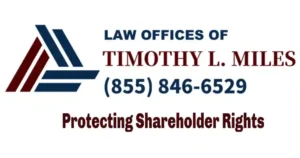Introduction to the Tempus AI Class Action Lawsuit
If you suffered substantial losses and wish to serve as lead plaintiff of the Tempus AI class action lawsuit, or just have general questions about you rights as a shareholder, please contact attorney Timothy L. Miles of the Law Offices of Timothy L. Miles, at no cost, by calling 855/846-6529 or via e-mail at [email protected]. Lead plaintiff motions for the Tempus AI class action lawsuit must be filed with the court no later than August 12, 2025.
In this comprehensive guide, you will learn everything an investor need to know about the fundamentals of securities class actions just like the Tempus AI lawsuit.
Understanding Securities Fraud Class Action Lawsuits
Securities fraud class action lawsuits represent a significant legal mechanism for investors who have suffered financial losses due to corporate malfeasance. These lawsuits, such as the Tempus AI lawsuit, typically arise when a company or its executives engage in deceptive practices that mislead investors about the company’s financial health or prospect.
The goal of such litigation is to hold the perpetrators accountable and secure compensation for the affected investors. Securities fraud encompasses a range of activities, including insider trading, false financial statements, and misleading disclosures, all of which can severely impact market integrity and investor confidence.

In a class action context, a group of investors collectively brings the lawsuit against the defendant, which could be a corporation or its executives. This collective approach is particularly powerful in the securities realm because it allows individual investors, who might not have the resources to pursue litigation on their own, to band together and seek justice.
The class action mechanism ensures that the legal process is efficient and that the interests of all affected investors are represented.
The complexity of securities fraud class action lawsuits requires plaintiffs to navigate a labyrinth of legal standards and procedural hurdles. One of the most significant challenges is surviving a motion to dismiss, a legal maneuver by the defendants to have the case thrown out before it reaches trial.
Understanding the nuances of these lawsuits is crucial for any stakeholder involved, as it sets the stage for the strategic decisions that will follow. In the case of the Tempus AI class action lawsuit, these elements come into sharp focus, highlighting the importance of a well-crafted legal strategy.
Overview of the Tempus AI Class Action Lawsuit
The Tempus AI lawsuit is a securities class action lawsuit that centers on allegations of misleading investors through the provision of inaccurate or incomplete information regarding the company’s financial status and operations. Such allegations, if proven true, could result in significant legal and financial consequences for Tempus AI. You need to grasp the magnitude of these claims and their potential impact on the company’s future.
Understanding the lawsuit requires analyzing the details of the allegations. Investors claim that Tempus AI’s disclosures were not as transparent as they should have been, leading to financial losses once the truth was revealed. Legal experts are examining whether there was a deliberate attempt to mislead stakeholders, which could lead to punitive measures.
For anyone involved in investing, the Tempus AI class action lawsuit serves as a stark reminder of the importance of due diligence and the risks associated with corporate investments. As you navigate through the nuances of this case, consider how transparency and accountability play pivotal roles in maintaining investor trust and confidence in the market.
Allegations in the Tempus AI Class Action Lawsuit
Tempus AI is a technology company advancing precision medicine through the practical application of artificial intelligence, including generative AI.
The Tempus AI class action lawsuit alleges that defendants throughout the Class Period made false and/or misleading statements and/or failed to disclose that:
- Tempus AI inflated the value of contract agreements, many of which were with related parties, included non-binding opt-ins and/or were self-funded;
- The credibility and substance of Tempus AI’s joint venture with SoftBank Group Corporation was at risk because it gave the appearance of “round-tripping” capital to create revenue for Tempus AI;
- Tempus AI-acquired Ambry Genetics Corporation had a business model based on aggressive and potentially unethical billing practices that risked scrutiny and unsustainability;
- AstraZeneca PLC had reduced its financial commitments to Tempus AI through a questionable “pass-through payment” via a joint agreement between it, Tempus AI, and Pathos AI, Inc.; and
- The above issues revealed weakness in core operations and revenue prospects.
The Tempus AI class action lawsuit further alleges that on May 28, 2025, Spruce Point Capital Management, LLC issued research report on Tempus AI that raised numerous red flags over Tempus AI’s management, operations, and financial reporting. On this news, the price of Tempus AI stock fell more than 19%, according to the complaint.

Who is Affected by the Tempus AI Class Action Lawsuit?
Identifying whether you are part of the affected group is crucial for understanding your rights and potential benefits. The Tempus AI Lawsuit may involve a specific time frame and set of circumstances that define the class of investors who can participate. Knowing these details will help you determine your eligibility and take appropriate action.
In addition to investors, the Tempus AI lawsuit can also impact the company’s executives, board members, and other stakeholders. The outcome of the lawsuit could influence Tempus AI’s reputation, financial stability, and future operations, affecting all parties associated with the company. Staying informed about the lawsuit’s progress is essential for anyone connected to Tempus AI.
How Securities Class Actions Work
The Tempus AI class action lawsuit, like most securities fraud cases, could take approximately 2.5 to 4 years to reach settlement. This timeline shows just one part of these complex legal proceedings.
Companies face securities fraud class actions when bad news makes their stock price drop by a lot. These cases make it tough for investors to get compensation. The Tempus AI lawsuit wants to recover damages as a group instead of individual claims. Research shows that plaintiffs’ lawyers take about 40% of any settlement, which cuts into what shareholders actually get back.
We wrote this piece to show you how securities class actions work from filing to final resolution. The stakes get really high when a class gets certified. Picture this: 50,000 shareholders each claim $10 per share in losses – that adds up to $500 million in potential damages.
Let’s look at how these cases play out and what you need to know about the whole process to better know what to expect in the Tempus AI class action lawsuit.
Understanding Securities Class Actions Like the Tempus AI Lawsuit
Securities class actions give investors a powerful way to recover their financial losses. Shareholders file these lawsuits when they believe companies misled them with false statements that drove up stock prices artificially. This is the exact scenario in the Tempus AI class action lawsuit.
What triggers a securities class action
A sharp drop in a company’s stock price usually kicks off a securities class action. This happens after new information comes to light that contradicts what the company told investors earlier. The new information usually comes from the company in the form of a corrective disclosure. The lawsuit represents all investors who bought securities during the “class period” – the time when alleged fraud or violations pushed the stock price up artificially.
These cases typically stem from:
- Fraudulent stock manipulation or false statements to investors
- Misleading information in prospectuses, earnings announcements, or SEC filings
- Financial statements that violated Generally Accepted Accounting Principles
- Restatement of previously issued financial statements
Most claims fall under the Securities Act of 1933 and the Securities Exchange Act of 1934. Rule 10b-5 stands out as the legal framework investors use most often when they suspect fraud in stock exchange transactions.
How the Tempus AI Lawsuit fits this model

The Tempus AI class action lawsuit shows this pattern clearly. Investors who bought Tempus AI securities between August 6, 2024 and May 27, 2025 filed the Tempus AI lawsuit claiming several false and misleading statements:
- Tempus AI inflated the value of contract agreements, many of which were with related parties, included non-binding opt-ins and/or were self-funded;
- The credibility and substance of Tempus AI’s joint venture with SoftBank Group Corporation was at risk because it gave the appearance of “round-tripping” capital to create revenue for Tempus AI;
- Tempus AI-acquired Ambry Genetics Corporation had a business model based on aggressive and potentially unethical billing practices that risked scrutiny and unsustainability;
- AstraZeneca PLC had reduced its financial commitments to Tempus AI through a questionable “pass-through payment” via a joint agreement between it, Tempus AI, and Pathos AI, Inc.; and
- The above issues revealed weakness in core operations and revenue prospects.
The core argument in the Tempus AI class action lawsuit matches most securities class actions – investors lost money because the stock’s artificially high price crashed once the truth came out.
Step-by-Step Breakdown of the Legal Process in the Tempus AI Lawsuit
The legal process behind securities class actions like the Tempus AI class action lawsuit follows a carefully coordinated series of steps. Each step has specific timelines and procedural requirements.
Filing the Original Complaint
Multiple law firms typically file similar complaints against the same defendants in securities class actions. A press release announcing the first lawsuit triggers a 60-day deadline for shareholders to step forward as lead plaintiff. Lawyers rush this original filing because they know a more detailed united complaint will follow.
Lead Plaintiff Selection and Uniting Cases

Investors must file motions to request appointment as lead plaintiff within 60 days of the first notice. The courts generally appoint the movant who has the largest financial stake in the litigation. This movant must also be “typical” and “adequate” as defined in Rule 23 of the Federal Rules of Civil Procedure. The selected lead plaintiff then unites the cases into a single action and their chosen attorney becomes lead counsel.
Motion to Dismiss and Its Effect
As you will see in the Tempus AI class action lawsuit, Defendants file a motion to dismiss the united complaint almost every time. The PSLRA automatically stops discovery during this period, which prevents plaintiffs from getting documents or testimony. This motion marks a crucial point—courts dismissed about 43% of securities class actions at this stage from 1997 through 2018.
Discovery and Evidence Gathering
The discovery process starts if the court denies the motion to dismiss. Parties exchange document requests, interrogatories, and take depositions. This expensive process takes a long time and often involves millions of document pages, and the PepGen class action lawsuit.
Class Certification under Rule 23
Plaintiffs must prove these elements to certify a class:
- Numerosity (typically at least 40 members)
- Commonality (shared questions of law or fact)
- Typicality (representative claims similar to class members)
- Adequacy of representation
Summary Judgment and Trial Preparation
Defendants often file for summary judgment based on undisputed facts after discovery ends. This gives them another chance to end the case before trial. Less than 1% of securities class actions reach trial verdict.
Key Challenges Plaintiffs in the Tempus AI Lawsuit Must Overcome
Plaintiffs who filed the Tempus AI class action lawsuit must overcome several tough challenges to win their case. The Private Securities Litigation Reform Act (PSLRA) and court interpretations create these roadblocks.
Proving scienter and intent
The PSLRA sets a tough standard that makes plaintiffs show a “strong inference” of scienter—knowledge of wrongdoing or reckless disregard for the truth. Courts take a “hard look” at these claims and evaluate them with an all-encompassing approach. Many plaintiffs rely on confidential witnesses to support their scienter claims.
Courts inspect these allegations with great care and get into their detail level and plausibility. The Tempus AI lawsuit faces a big challenge. Showing that executives knew their statements were false needs more than just proving they had access to contrary information. Plaintiffs must connect specific data source contents to particular statements.
Establishing loss causation
A direct link between alleged misrepresentations and economic losses must exist. Plaintiffs usually need to point out “corrective disclosures” that revealed the truth and made stock prices fall. The usual method requires proof that misrepresentations artificially pushed up the purchase price. The truth coming out later must have caused the value to drop. This remains nowhere near easy to prove, especially when dealing with “fraud on the market” cases.
Demonstrating price impact
Defendants can stop class certification by proving lack of price impact—showing alleged misstatements didn’t move the stock price. The Supreme Court’s decision in Goldman Sachs v. Arkansas Teacher Retirement System requires courts to think about whether generic statements could really affect stock prices. Defendants in the Tempus AI lawsuit must prove there’s no price impact by a preponderance of evidence.
Meeting class certification standards
Class certification in the Tempus AI class action lawsuit will be a crucial battleground the courts will perform a “rigorous analysis” of Rule 23 requirements. Hard evidence, not just allegations, must show these requirements are met. Courts get into whether common questions outweigh individual issues.
They also check if the proposed representative truly speaks for class interests. Class certification has become tougher, and defendants have found some success in challenging plaintiffs’ claims, and you can expect the same arguments in the Tempus AI lawsuit.
How Most Cases Are Resolved
Securities class actions rarely make it to trial, as settlement remains the most common way to resolve these cases. Most cases that survive a motion to dismiss ended up reaching settlement. Less than 1% of cases actually go to trial verdict.
The role of mediation
Securities class action mediation is different from other legal proceedings because of the massive amounts at stake and complex laws involved. Independent mediators don’t make decisions but help both parties reach an agreement they can accept.
Early mediation helps parties learn about opposing viewpoints and build mutually beneficial alliances with insurance carriers, even when immediate settlement doesn’t happen. These sessions involve detailed discussions about case merits through separate meetings with each side.
Settlement process and court approval
The PSLRA requires specific notifications to class members after parties reach an agreement. These notifications must include:
- The proposed distribution amount
- Statement of potential case outcomes
- Attorneys’ fees and costs requested
- Identification of available plaintiff’s counsel
- Explanation of settlement reasons
- Additional court-required information
Class members in the Tempus AI class action lawsuit can file objections or choose to opt out after receiving notification. The court assesses if the settlement is appropriate through a hearing where both sides present their arguments.
Claims administration and payout timeline
If there is a settlement in the Tempus AI class action lawsuit, an independent claims administrator will handle the distribution of settlement funds after approval. These specialized firms manage everything in the claims process – from identifying eligible security positions to calculating losses and sending payments.
A typical securities class action takes about two to three years to conclude after filing. Administrators might make second or third distributions after the initial payout, especially when they hold back money to cover late claims in bigger cases.
Class members receive settlements in cash, stock, or both based on their calculated losses. The maximum possible recovery equals losses from illegal conduct, but parties rarely achieve this amount.
Conclusion
Securities class actions like the Tempus AI class action lawsuit are complex legal battles that create big hurdles for investors who want compensation. The Tempus AI lawsuit shows how these cases take several years to move through a well-laid-out legal process.
Plaintiffs don’t have it easy during these proceedings. They need to prove scienter, establish loss causation, show price impact, and meet strict class certification requirements. These roadblocks explain why almost half of all securities class actions don’t make it past the motion to dismiss stage.
Cases that survive the original dismissal attempts usually end in settlement. Most resolutions take 2-3 years, and shareholders get compensation based on their proven losses. Investors in the Tempus AI class action lawsuit should brace themselves for a long journey ahead.
The settlement distribution process helps paint a clearer picture of what to expect. While claims administrators tackle the complex job of figuring out individual payouts, shareholders should know their actual recovery is nowhere near the maximum possible damages. Legal teams typically take about 40% of settlements, which cuts into what individual investors receive.
Securities class actions definitely offer a way to deal with alleged corporate wrongdoing. Their ability to work as compensation vehicles faces limits from procedural hurdles, long timelines, and reduced payouts. The Tempus AI class action lawsuit shows these dynamics at work and gives us a clear view of how these specialized legal proceedings work in our financial markets.
Contact Timothy L. Miles Today About an Tempus AI lawsuit Class Action Lawsuit
If you suffered losses in Tempus AI stock, call us today for a free case evaluation about an Tempus AI Class Action Lawsuit. 855-846-6529 or [email protected] (24/7/365).
Timothy L. Miles, Esq.
Law Offices of Timothy L. Miles
Tapestry at Brentwood Town Center
300 Centerview Dr. #247
Mailbox #1091
Brentwood,TN 37027
Phone: (855) Tim-MLaw (855-846-6529)
Email: [email protected]
Website: www.classactionlawyertn.com
Facebook Linkedin Pinterest youtube



